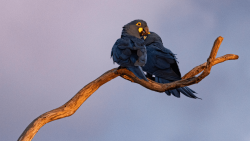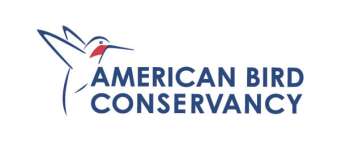ABC’s Search for Lost Birds Partnership with BirdLife International and Re:wild has paid dividends with successes for three lost birds. Recently, an expedition team led by the Peregrine Fund’s Madagascar Program, and including ABC’s John C. Mittermeier, rediscovered the Dusky Tetraka, a small olive-colored and yellow-throated bird that has eluded ornithologists for 24 years. It was one of the Top Ten most wanted species by the Search for Lost Birds. •Last year in Colombia, ABC supported our partner Selva’s fieldwork on the Santa Marta Sabrewing, an endemic hummingbird that was rediscovered after not being seen for more than 10 years. The ABC-funded follow-up surveys have recorded additional observations of the species, along with the first-ever photos of a female. •Meanwhile, ABC’s John C. Mittermeier co-led an expedition in Papua New Guinea which rediscovered the Critically Endangered Black-naped Pheasant-Pigeon, a species known only to a few local hunters and by specimens collected 140 years ago.
ABC supported our Ecuadorian partner Fundación para la Conservación de los Andes Tropicales (FCAT) in expanding its reserve protecting some of the last remaining Chocó forest habitat in the world. The expansion brings the reserve's total size up to 1,546 acres and will provide additional protected habitat for imperiled species including the Endangered Banded Ground-Cuckoo and Vulnerable Long-wattled Umbrellabird.
Conserving Habitats: ABC aims to maintain the abundance and diversity of birds and reverse trends for declining species, by conserving and restoring key areas of habitat across their lifecycles. Many of these critical places are encompassed within ABC’s BirdScapes approach, which aims to reverse the staggering declines of migratory birds. In addition, we work through the multi-partner Migratory Bird Joint Ventures (JVs) rallying diverse stakeholders to manage habitats for the birds most in need.
The ABC-led Appalachian Mountains Joint Venture enhanced and restored over 6,700 acres of forests within several regional BirdScapes that contributed to recovering populations of declining species including Cerulean and Golden-winged Warbler and Wood Thrush. In Pennsylvania, for the benefit of those same species, our Dynamic Forest Restoration program with multiple partners completed comprehensive forest restoration plans covering 51,790 acres, and implemented 6,508 acres of forest stewardship projects to enhance breeding habitat. In addition, The Lower Mississippi Valley Joint Venture partnership restored 22,337 acres of open pine forest on private lands in Arkansas, Louisiana, and Texas, providing habitat for birds such as the Red-headed Woodpecker and Northern Bobwhite.
ABC and partners — including several Joint Ventures — worked together in 2022 to improve more than 250,000 acres of habitat for rapidly disappearing bird species, most of them migratory and requiring conservation across vast areas. The ABC-led Central Hardwoods Joint Venture partners restored 132,571 acres of woodlands, completed 22,722 acres of native grassland planting, and 8,954 acres of forest management enhancements, for the benefit of Red-headed Woodpecker, Brown-headed Nuthatch, Prairie Warbler (Photo below, Anne Lindgren, Shutterstock), Grasshopper Sparrow, and Northern Bobwhite.
Eliminating Threats: ABC works to prevent or mitigate threats to birds by working with policymakers, partner groups, and the private sector to develop and implement solutions to large-scale causes of bird mortality, along with precedent-setting or critical regional bird problems. This work involves lobbying, grassroots outreach, the development of new technologies, and occasional legal action to resolve particularly intractable problems.
Public Employees for Environmental Responsibility and ABC are leading a regulatory filing with the Environmental Protections Agency (EPA) on behalf of 65 nonprofit groups. The filing proposes major reforms in the way the agency regulates systemic insecticides. It focuses in particular on neonicotinoids (neonics), pesticides often applied as agricultural seed coatings that have caused excessive honeybee deaths, native bee declines, and bird mortalities since their introduction more than 20 years ago. There is overwhelming evidence neonics are devastating to birds, such as the Eastern Bluebird and one seed coated with these pesticides can kill a songbird.
In March, both federal and state-level public prosecutors filed a lawsuit to nullify licenses for the Canudos Wind Complex, a wind power project under construction in habitat essential to the survival of the Endangered Lear's Macaw. The lawsuit asserts that Environmental Impact Assessment and public hearing laws were not followed before construction began. If the lawsuit is successful, Voltalia's wind project could be required to take steps to mitigate its environmental harm, or it could be relocated out of Lear's Macaw habitat. With Brazilian partners, ABC has supported successful efforts to conserve the Lear's Macaw in the area for decades, including the expansion of the Canudos Biological Station Reserve. Previously, a group comprising 70 organizations and community associations, and supported by https://dariuszzdziebk.wpenginepowered.com/wp-content/uploads/2022/12/L…, WWF, and Re:wild, had appealed for help with a formal complaint to the United Nations. The area where 28 wind turbines are currently under construction is formally recognized for its environmental importance as a Key Biodiversity Area and Alliance for Zero Extinction (AZE) site. (Lear’s Macaw photo below, Bennett Hennessey).





